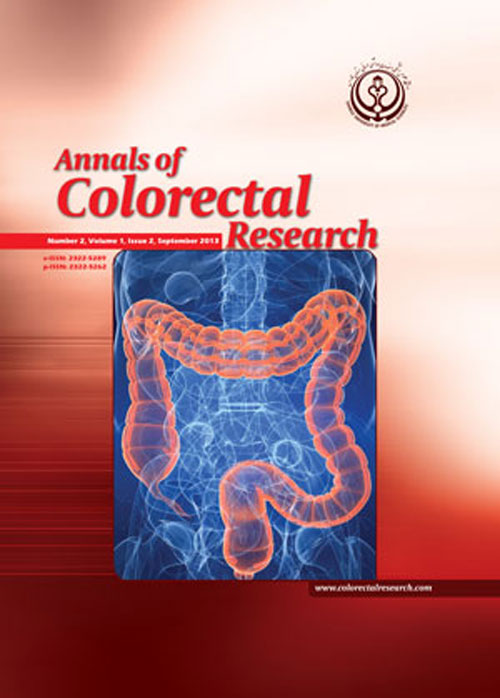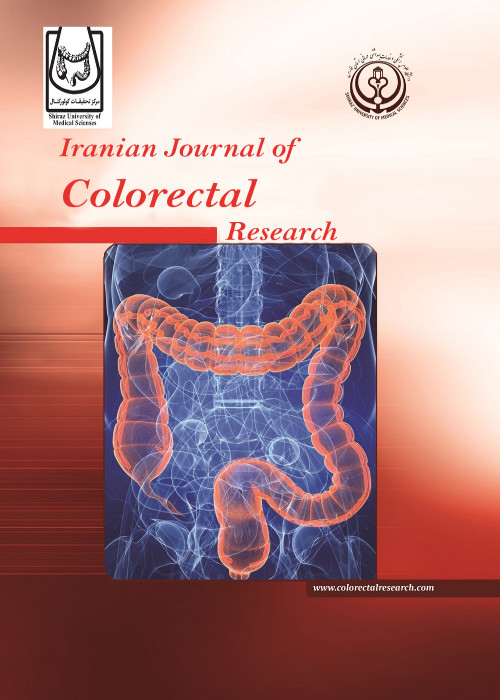فهرست مطالب

Iranian Journal of Colorectal Research
Volume:3 Issue: 3, Sep 2015
- تاریخ انتشار: 1394/07/05
- تعداد عناوین: 6
-
-
Page 1IntroductionExtramammary Paget’s disease is a rare neoplasm of the skin that might develop in perianal region. Although different management options are available, wide local excision is still the method of choice..Case PresentationA 45-year-old man presented with perianal itchy lesions for one year with no response to local treatments. Perianal Paget’s disease was diagnosed by performing a surgical biopsy. Wide excision and flap reconstruction was done, while loop sigmoid colostomy was performed for fecal diversion. Re-excision of the involved margins was performed during the second operation..ConclusionsA good outcome and no recurrence or complications was noticed in a follow-up period of 24 months. It is important to consider this uncommon disease as a probable diagnosis when evaluating a perianal lesion..Keywords: Paget Disease Extramammary, Perianal Glands, Local Excision
-
Page 2Context: Colorectal cancer is one of the most common cancers worldwide (the third most common cancer in the world) and is especially more common in Western countries; however, its incidence has been increased significantly during the last few years in Eastern countries such as Iran and considered as one of the five common cancers in this country. According to molecular pathways, numerous biomarkers have been identified for colorectal cancers which help patients’ management..Evidence aquisition: In this study, we tried to review published articles about the molecular biomarkers of colorectal cancer from Iran. We searched medical databases such as google scholar, Scopus, PubMed, Magiran, SID and Iran Medex for keywords of “colon cancer, KRAS, BRAF, mismatch repair gene, Microsatellite instability, molecular genetics, molecular pathogenesis, biomarker and Iran” to find studies published about colorectal cancers from Iran regarding molecular biomarkers..ConclusionThis study showed that molecular biomarkers in colorectal cancer of Iranian patients are not so different from Western population..Keywords: Biological Markers, Colorectal Cancer, Cancer
-
Page 3BackgroundSuturing quality and reducing its complications and resulting infection have always been a major concern of surgeons. Many of them have prohibited applying polyfilament and absorbable suturing materials..ObjectivesIn this study, we compared skin wound infection rate and other complications in two groups of post appendectomy patients whom were treated with two types of suturing materials - conventionally used Nylon and absorbable braided polyglactin (Vicryl) - and wound healing, existence of complication and recovery course of treated patients were surveyed..Patients andMethodsA total of 130 patients who underwent appendectomy were divided into two groups of 645 members, each. Patients in group A had their incisions closed by separate sutures (mattress method) by vicryl, while patients in group B had their surgical incisions were closed in the same method, by nylon sutures. Any signs and symptoms of surgical site wound infection like inappropriate pain, redness, discharge, bulging, and unhealing wound were checked during hospital stay and on the 7th - 9th day postoperatively..ResultsThe postsurgical complication and infections rates were similar between the two groups..ConclusionsVicryl sutures can safely be used for skin and subcutaneous wound suturing even when our surgery site is not ideally clean..Keywords: Polyglactin 910, Wound Infection, Sutures


